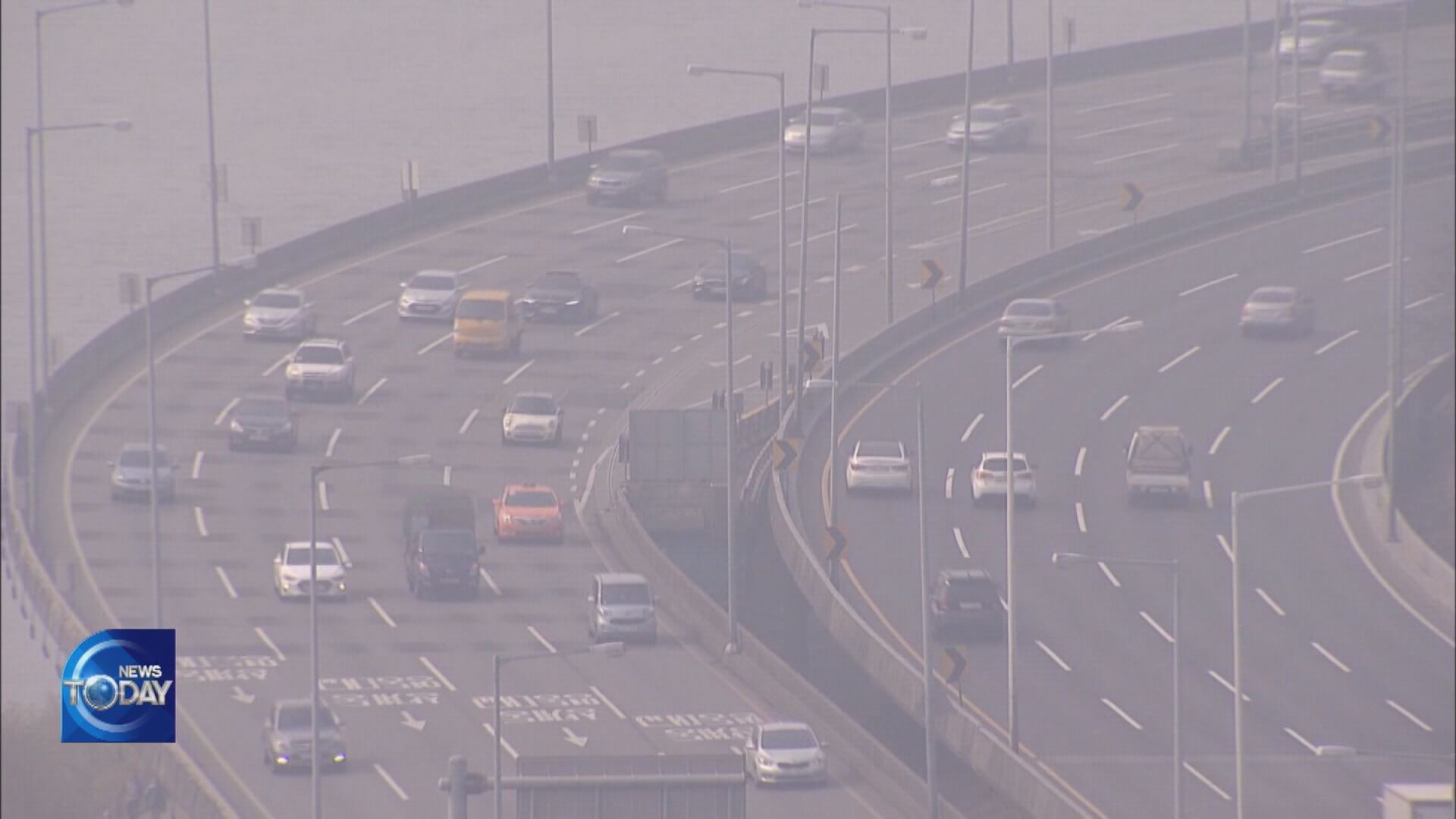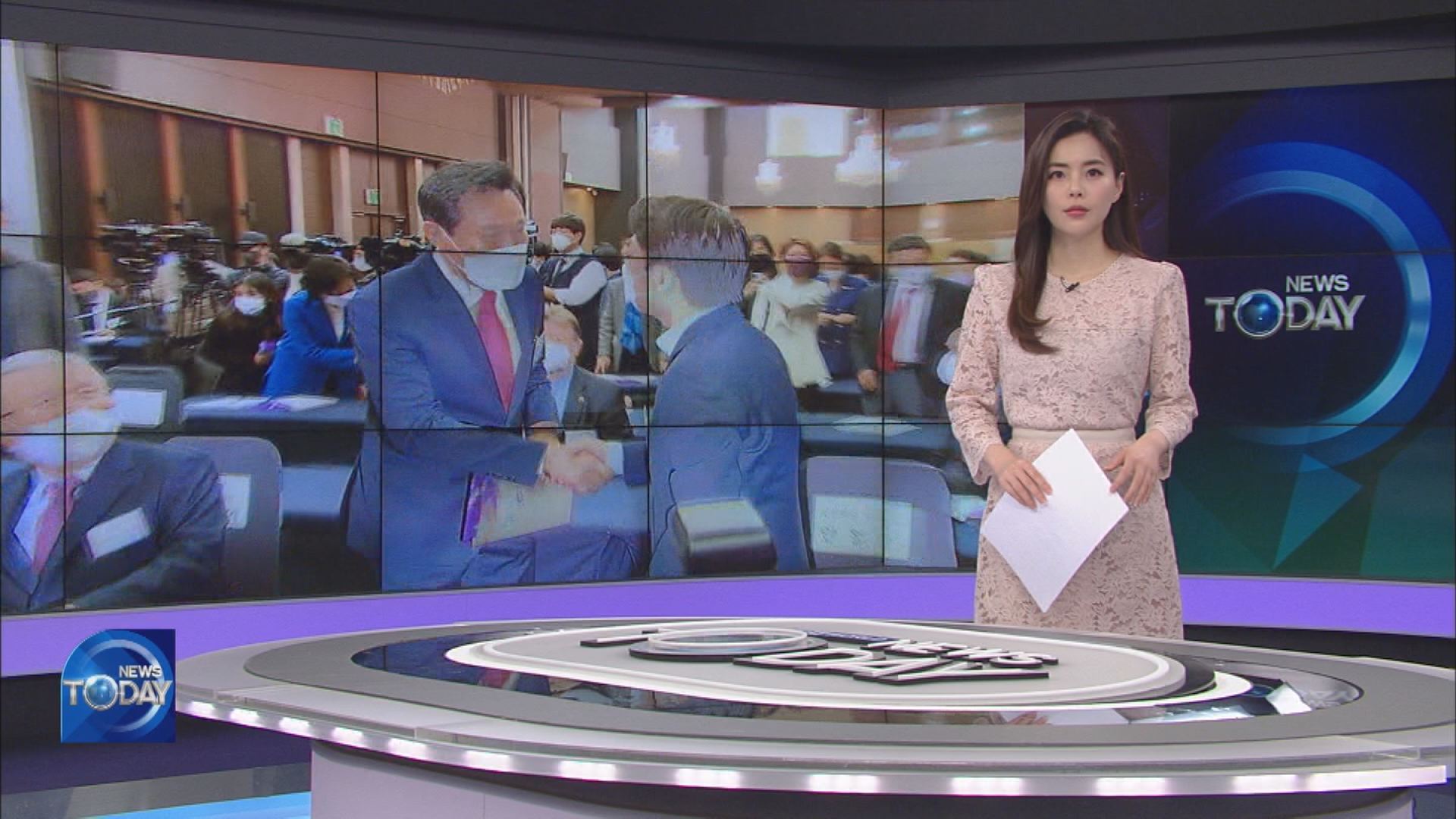FINE DUST EMERGENCY REDUCTION MEASURES
입력 2021.03.11 (15:20)
수정 2021.03.11 (16:45)
읽어주기 기능은 크롬기반의
브라우저에서만 사용하실 수 있습니다.
[Anchor Lead]
Air usually remains clean during winter when strong cold winds blow away dust and pollutants. In fact, super-fine particulate matters in the past few months fell to a record low level. But warmer temperatures brought back higher levels of ultra-fine dust and emergency reduction measures have been put in place in the capital region for the first time this year.
[Pkg]
While Koreans had to endure freezing winter winds, fine dust concerns were laid to rest for a while. In fact, the nation’s average level of ultra-fine particles, marked as PM 2.5, over the past winter was 23 micrograms per cubic meter, an on-year decline of 12%. It was the lowest PM 2.5 level since nationwide monitoring began in 2015. The number of highly polluted days also decreased. Thirteen days were recorded as “bad” or worse, which is just half the average of the last three years. The number of “good” days nearly doubled. The Ministry of Environment attributed the improvements to the seasonal fine dust control system, reduction in traffic due to the pandemic, and favorable climate conditions.
[Soundbite] Kim Seung-hee(Chief, Air Quality Policy Bureau, Ministry of Environment) : "The seasonal control system led to the reduction of additional 10,000 tons or a 28% reduction effect. Also, there were climate factors."
The strong, cold winds blew away pollutants before they had a chance to accumulate.
But the winds started to die down since mid-February, Wednesday’s wind speed in Seoul was less than 2 meters per second. The calmer atmosphere resulted in a hazy mixture of fog and dust for the capital. Thursday's air pollution levels for the Seoul metropolitan area and Chungcheong and Jeollabuk-do regions are expected to be high throughout the day, and some parts of the capital region will experience very bad air conditions. A band of high-density fine dust is projected to remain over Korea’s western region all through the week.
[Soundbite] Kim Sung-woo(Nat’l Institute of Environmental Research) : "Due to stagnant air and pollution from overseas, the ultra-fine dust levels will remain high for the capital and Chungcheong region until next Monday."
The year’s first emergency fine dust reduction measures were ordered for Seoul and surrounding areas. Vehicles with level 5 gas emission will be restricted and construction hours will be shortened. These measures may be extended depending on Thursday's air pollution level.
Air usually remains clean during winter when strong cold winds blow away dust and pollutants. In fact, super-fine particulate matters in the past few months fell to a record low level. But warmer temperatures brought back higher levels of ultra-fine dust and emergency reduction measures have been put in place in the capital region for the first time this year.
[Pkg]
While Koreans had to endure freezing winter winds, fine dust concerns were laid to rest for a while. In fact, the nation’s average level of ultra-fine particles, marked as PM 2.5, over the past winter was 23 micrograms per cubic meter, an on-year decline of 12%. It was the lowest PM 2.5 level since nationwide monitoring began in 2015. The number of highly polluted days also decreased. Thirteen days were recorded as “bad” or worse, which is just half the average of the last three years. The number of “good” days nearly doubled. The Ministry of Environment attributed the improvements to the seasonal fine dust control system, reduction in traffic due to the pandemic, and favorable climate conditions.
[Soundbite] Kim Seung-hee(Chief, Air Quality Policy Bureau, Ministry of Environment) : "The seasonal control system led to the reduction of additional 10,000 tons or a 28% reduction effect. Also, there were climate factors."
The strong, cold winds blew away pollutants before they had a chance to accumulate.
But the winds started to die down since mid-February, Wednesday’s wind speed in Seoul was less than 2 meters per second. The calmer atmosphere resulted in a hazy mixture of fog and dust for the capital. Thursday's air pollution levels for the Seoul metropolitan area and Chungcheong and Jeollabuk-do regions are expected to be high throughout the day, and some parts of the capital region will experience very bad air conditions. A band of high-density fine dust is projected to remain over Korea’s western region all through the week.
[Soundbite] Kim Sung-woo(Nat’l Institute of Environmental Research) : "Due to stagnant air and pollution from overseas, the ultra-fine dust levels will remain high for the capital and Chungcheong region until next Monday."
The year’s first emergency fine dust reduction measures were ordered for Seoul and surrounding areas. Vehicles with level 5 gas emission will be restricted and construction hours will be shortened. These measures may be extended depending on Thursday's air pollution level.
■ 제보하기
▷ 카카오톡 : 'KBS제보' 검색, 채널 추가
▷ 전화 : 02-781-1234, 4444
▷ 이메일 : kbs1234@kbs.co.kr
▷ 유튜브, 네이버, 카카오에서도 KBS뉴스를 구독해주세요!
- FINE DUST EMERGENCY REDUCTION MEASURES
-
- 입력 2021-03-11 15:20:00
- 수정2021-03-11 16:45:30

[Anchor Lead]
Air usually remains clean during winter when strong cold winds blow away dust and pollutants. In fact, super-fine particulate matters in the past few months fell to a record low level. But warmer temperatures brought back higher levels of ultra-fine dust and emergency reduction measures have been put in place in the capital region for the first time this year.
[Pkg]
While Koreans had to endure freezing winter winds, fine dust concerns were laid to rest for a while. In fact, the nation’s average level of ultra-fine particles, marked as PM 2.5, over the past winter was 23 micrograms per cubic meter, an on-year decline of 12%. It was the lowest PM 2.5 level since nationwide monitoring began in 2015. The number of highly polluted days also decreased. Thirteen days were recorded as “bad” or worse, which is just half the average of the last three years. The number of “good” days nearly doubled. The Ministry of Environment attributed the improvements to the seasonal fine dust control system, reduction in traffic due to the pandemic, and favorable climate conditions.
[Soundbite] Kim Seung-hee(Chief, Air Quality Policy Bureau, Ministry of Environment) : "The seasonal control system led to the reduction of additional 10,000 tons or a 28% reduction effect. Also, there were climate factors."
The strong, cold winds blew away pollutants before they had a chance to accumulate.
But the winds started to die down since mid-February, Wednesday’s wind speed in Seoul was less than 2 meters per second. The calmer atmosphere resulted in a hazy mixture of fog and dust for the capital. Thursday's air pollution levels for the Seoul metropolitan area and Chungcheong and Jeollabuk-do regions are expected to be high throughout the day, and some parts of the capital region will experience very bad air conditions. A band of high-density fine dust is projected to remain over Korea’s western region all through the week.
[Soundbite] Kim Sung-woo(Nat’l Institute of Environmental Research) : "Due to stagnant air and pollution from overseas, the ultra-fine dust levels will remain high for the capital and Chungcheong region until next Monday."
The year’s first emergency fine dust reduction measures were ordered for Seoul and surrounding areas. Vehicles with level 5 gas emission will be restricted and construction hours will be shortened. These measures may be extended depending on Thursday's air pollution level.
Air usually remains clean during winter when strong cold winds blow away dust and pollutants. In fact, super-fine particulate matters in the past few months fell to a record low level. But warmer temperatures brought back higher levels of ultra-fine dust and emergency reduction measures have been put in place in the capital region for the first time this year.
[Pkg]
While Koreans had to endure freezing winter winds, fine dust concerns were laid to rest for a while. In fact, the nation’s average level of ultra-fine particles, marked as PM 2.5, over the past winter was 23 micrograms per cubic meter, an on-year decline of 12%. It was the lowest PM 2.5 level since nationwide monitoring began in 2015. The number of highly polluted days also decreased. Thirteen days were recorded as “bad” or worse, which is just half the average of the last three years. The number of “good” days nearly doubled. The Ministry of Environment attributed the improvements to the seasonal fine dust control system, reduction in traffic due to the pandemic, and favorable climate conditions.
[Soundbite] Kim Seung-hee(Chief, Air Quality Policy Bureau, Ministry of Environment) : "The seasonal control system led to the reduction of additional 10,000 tons or a 28% reduction effect. Also, there were climate factors."
The strong, cold winds blew away pollutants before they had a chance to accumulate.
But the winds started to die down since mid-February, Wednesday’s wind speed in Seoul was less than 2 meters per second. The calmer atmosphere resulted in a hazy mixture of fog and dust for the capital. Thursday's air pollution levels for the Seoul metropolitan area and Chungcheong and Jeollabuk-do regions are expected to be high throughout the day, and some parts of the capital region will experience very bad air conditions. A band of high-density fine dust is projected to remain over Korea’s western region all through the week.
[Soundbite] Kim Sung-woo(Nat’l Institute of Environmental Research) : "Due to stagnant air and pollution from overseas, the ultra-fine dust levels will remain high for the capital and Chungcheong region until next Monday."
The year’s first emergency fine dust reduction measures were ordered for Seoul and surrounding areas. Vehicles with level 5 gas emission will be restricted and construction hours will be shortened. These measures may be extended depending on Thursday's air pollution level.
이 기사가 좋으셨다면
-
좋아요
0
-
응원해요
0
-
후속 원해요
0












![[속보] 금강서 물놀이하다 실종된 4명 모두 심정지 <br>상태로 발견](/data/news/2025/07/09/20250709_ErovgL.jpg)

![[단독] ‘공천개입 핵심 물증’ 윤상현 휴대전화 미제출…야간 추가 압수수색도 실패](/data/layer/904/2025/07/20250709_dRidEM.png)


이 기사에 대한 의견을 남겨주세요.